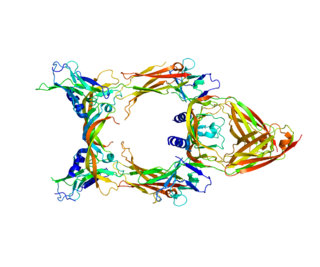Collagen and calcium-binding EGF domain-containing protein 1 is a protein that in humans is encoded by the CCBE1 gene. [5] [6]
Collagen and calcium-binding EGF domain-containing protein 1 is a protein that in humans is encoded by the CCBE1 gene. [5] [6]
CCBE1 is a regulator of the development and growth of the lymphatic system. CCBE1 is necessary for the proteolytic activation of VEGF-C by ADAMTS3, [7] which is the main growth factor for the lymphatic system. [8]
Hennekam syndrome type I (a generalized lymphatic dysplasia in humans) is associated with mutations in the CCBE1 gene, [9] and the molecular etiology of the disease has been elucidated. [7]

Vascular endothelial growth factor C (VEGF-C) is a protein that is a member of the platelet-derived growth factor / vascular endothelial growth factor (PDGF/VEGF) family. It is encoded in humans by the VEGFC gene, which is located on chromosome 4q34.

Cadherin EGF LAG seven-pass G-type receptor 2 is a protein that in humans is encoded by the CELSR2 gene.

Cadherin EGF LAG seven-pass G-type receptor 1 also known as flamingo homolog 2 or cadherin family member 9 is a protein that in humans is encoded by the CELSR1 gene.

Progressive ankylosis protein homolog is a protein that in humans is encoded by the ANKH gene.

C-fos-induced growth factor (FIGF) is a vascular endothelial growth factor that in humans is encoded by the FIGF gene.

Collagen alpha-1(IX) chain is a protein that in humans is encoded by the COL9A1 gene.

Collagen alpha-2(IX) chain is a protein that in humans is encoded by the COL9A2 gene.

Collagen alpha-3(IX) chain is a protein that in humans is encoded by the COL9A3 gene.

Lymphatic vessel endothelial hyaluronan receptor 1 (LYVE1), also known as extracellular link domain containing 1 (XLKD1) is a Link domain-containing hyaladherin, a protein capable of binding to hyaluronic acid (HA), homologous to CD44, the main HA receptor. In humans it is encoded by the LYVE1 gene.

EGF-containing fibulin-like extracellular matrix protein 2 is a protein that in humans is encoded by the EFEMP2 gene.

Protein kinase C-binding protein NELL1 also known as NEL-like protein 1 (NELL1) or Nel-related protein 1 (NRP1) is a protein that in humans is encoded by the NELL1 gene.

Voltage-dependent calcium channel gamma-3 subunit is a protein that in humans is encoded by the CACNG3 gene.

Dymeclin is a protein that in humans is encoded by the DYM gene.

A disintegrin and metalloproteinase with thrombospondin motifs 3 is an enzyme that in humans is encoded by the ADAMTS3 gene. The protein encoded by this gene is the major procollagen II N-propeptidase.
The lymphatic endothelium is a specialised form of epithelium, distinct from but similar to vascular endothelium. A lymph capillary endothelial cell is distinct from other endothelial cells in that collagen fibers are directly attached to its plasma membrane.

Bardet–Biedl syndrome 9 is a protein that in humans is encoded by the BBS9 gene.

Hennekam syndrome also known as intestinal lymphagiectasia–lymphedema–mental retardation syndrome, is an autosomal recessive disorder consisting of intestinal lymphangiectasia, facial anomalies, peripheral lymphedema, and mild to moderate levels of growth and intellectual disability.

Wnt-10a is a protein that in humans is encoded by the WNT10A gene.

Coiled-coil and C2 domain-containing protein 2A that in humans is encoded by the CC2D2A gene.
Michael Jeltsch is a German-Finnish researcher in the field of Biochemistry. He is an associate professor at the University of Helsinki, Finland. He has more than 70 publications. Jeltsch was the first to show that VEGF-C and VEGF-D are the principal growth factors for the lymphatic vasculature and his research focuses on cancer drug targets and lymphangiogenesis. He has also contributed to other seminal publications in cell biology with transgenesis, protein engineering, recombinant production and purification. In 2006, he developed a synthetic super-VEGF, using a library of VEGF hybrid molecules using a novel, non-random DNA family shuffling method.
This article incorporates text from the United States National Library of Medicine, which is in the public domain.